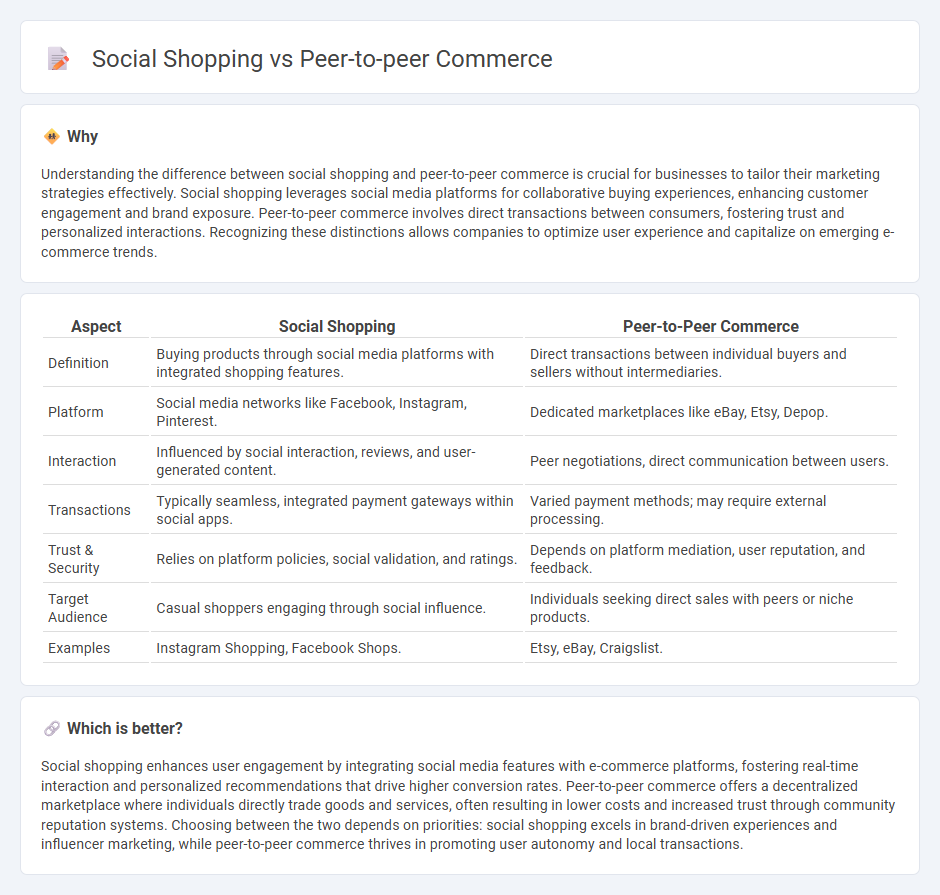
Social shopping leverages online communities where users share product recommendations, reviews, and shopping experiences, enhancing discovery through collective input. Peer-to-peer commerce enables direct transactions between individuals, often via digital platforms, facilitating unique item exchanges and personalized selling opportunities. Explore the nuances and benefits of these evolving commerce models to optimize your shopping strategy.
Why it is important
Understanding the difference between social shopping and peer-to-peer commerce is crucial for businesses to tailor their marketing strategies effectively. Social shopping leverages social media platforms for collaborative buying experiences, enhancing customer engagement and brand exposure. Peer-to-peer commerce involves direct transactions between consumers, fostering trust and personalized interactions. Recognizing these distinctions allows companies to optimize user experience and capitalize on emerging e-commerce trends.
Comparison Table
| Aspect | Social Shopping | Peer-to-Peer Commerce |
|---|---|---|
| Definition | Buying products through social media platforms with integrated shopping features. | Direct transactions between individual buyers and sellers without intermediaries. |
| Platform | Social media networks like Facebook, Instagram, Pinterest. | Dedicated marketplaces like eBay, Etsy, Depop. |
| Interaction | Influenced by social interaction, reviews, and user-generated content. | Peer negotiations, direct communication between users. |
| Transactions | Typically seamless, integrated payment gateways within social apps. | Varied payment methods; may require external processing. |
| Trust & Security | Relies on platform policies, social validation, and ratings. | Depends on platform mediation, user reputation, and feedback. |
| Target Audience | Casual shoppers engaging through social influence. | Individuals seeking direct sales with peers or niche products. |
| Examples | Instagram Shopping, Facebook Shops. | Etsy, eBay, Craigslist. |
Which is better?
Social shopping enhances user engagement by integrating social media features with e-commerce platforms, fostering real-time interaction and personalized recommendations that drive higher conversion rates. Peer-to-peer commerce offers a decentralized marketplace where individuals directly trade goods and services, often resulting in lower costs and increased trust through community reputation systems. Choosing between the two depends on priorities: social shopping excels in brand-driven experiences and influencer marketing, while peer-to-peer commerce thrives in promoting user autonomy and local transactions.
Connection
Social shopping leverages online platforms where consumers share product recommendations, reviews, and experiences, creating a community-driven buying environment. Peer-to-peer commerce thrives within these social ecosystems by enabling direct transactions between users, reducing dependency on traditional retailers. This connection enhances trust and personalization, as buyers rely on peer insights and social interactions to make informed purchasing decisions.
Key Terms
Decentralization
Peer-to-peer commerce leverages blockchain technology to enable decentralized transactions, eliminating intermediaries and enhancing trust through cryptographic verification. Social shopping platforms integrate community interactions with purchasing but often rely on centralized data control, limiting user autonomy and data privacy. Explore how decentralization transforms online shopping dynamics by empowering users and reshaping digital marketplaces.
Social influence
Social shopping leverages social influence through user-generated content, reviews, and real-time interactions within a network, creating a community-driven purchasing experience. Peer-to-peer commerce emphasizes direct transactions between individuals, where trust and reputation systems play a crucial role in influencing buyer decisions. Discover how social influence shapes consumer behavior in these evolving digital marketplaces.
Trust mechanisms
Peer-to-peer commerce relies heavily on decentralized trust mechanisms such as user reviews, rating systems, and escrow services to ensure secure transactions between individuals. Social shopping integrates trust through social proof, influencer endorsements, and community feedback within platforms to enhance buyer confidence. Explore deeper insights on how these trust mechanisms shape user behavior and transaction security in evolving digital marketplaces.
Source and External Links
Peer-to-peer Business Model - The peer-to-peer commerce model connects individuals directly to buy and sell goods or services via a platform that facilitates transactions, reduces risks, and lowers costs, with examples including Uber, Airbnb, and eBay.
Business model: Peer-to-Peer - Learning Loop - Peer-to-peer marketplaces thrive on network effects, allowing individuals to transact without inventory costs and middlemen, making these models highly scalable and cost-efficient for both buyers and sellers.
What is peer to peer marketplace? How to build a p2p ... - Peer-to-peer marketplaces are decentralized online platforms that enable individuals to transact directly with each other without intermediaries, usually categorized into product and service marketplaces, enhancing transparency and efficiency.
 dowidth.com
dowidth.com